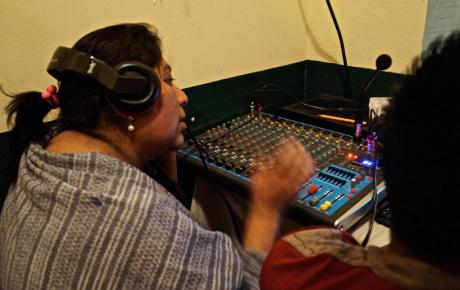In a small town in the east of Morelos, on a small console bought with the donations of hundreds of people, there are four RCA cables connected that give life to the recently created Community Radio Hueyapan 105.5. The radio embodies the maxim of Neil Armstrong, a small step forward for creating community, and a giant leap toward self-government in Hueyapan.
Community radio Hueyapan 105.5 FM is born: The science of communication is not studied, but is practiced
In a small town in the east of Morelos, in a small space of the municipal building, on a small desk—made with wood from the surrounding forests—, in a small console that was bought with the donations of hundreds of people, there are four RCA cables connected that give life to the recently created Community Radio Hueyapan 105.5. The radio embodies the maxim of Neil Armstrong, a small step forward for creating community, and a giant leap toward self-government that is cooking in Hueyapan.
Since January 9th, 2017, a dozen youth have voluntarily dedicated themselves to learning from direct experience how to produce a radio transmission synthesizing the everyday events to inform the people, as well as to give voice to the hundreds of calls and requests from the community to “play a song or send a greetings.” In the improvised cabin there is a console, a microphone that is connected directly to the plug, a desktop computer—already rattling from use—, a schedule for the announcers, and on the walls sheets of paper to note the authors and genres of music most requested for the week. “We do not study communication nor journalism, much less do we make a living from this. All of this is voluntary and I believe that the voluntary character and our own self-directed development of the science of communication is what provokes the many questions that we are resolving little by little.” In effect, the methods of community communication in the radios and the independent media have a significant objective that the specialists and “studied” people lack: to democratize communication.
The act of putting together a project of free communication moves us toward the conversion of information into a democratic and malleable substance ready to be exchanged between transmitter and receiver. The television and the architects of mass media are businesses directed by their respective bosses (personified like ideologues) that emphatically normalize, capitalize, and stylize information for consumption without giving space to other voices. Differently, the community radios develop programs based in necessities, pleasures, and processes of organization. In one of the meetings of the radio announcers, they gave an interesting anecdote: “the other day, one of the community members lost his mule, I was announcing at the time and I broadcasted the situation to circumvent the theft and to find those responsible. In just a few hours, the mule appeared thanks to the information given on the radio”, said one of the participants of the radio.
The members of the Communitarian Council for the Autonomy of Hueyapan related that “the radio is a small step that serves the work of consciousness raising and dialogue between the community to reach as soon as possible a new model of autonomy in all of the things we do here.” This refers to various objectives: a collective and anti-capitalist economy that is self-run by the campesinos, artists, and small local businesspeople, focusing on producing riches to be available to everyone in the communal treasury; a direct democracy—without payrolls and political parties—to elect their representatives from each block and from each neighborhood, forming counsels—with the right of revocation—that delegates different tasks of administration and supervision; the re-strengthening of the community guard “Los Tigres”, an organ of autonomous security that since 2014 has organized against the abuses and arbitrary detentions of the single-command police, and to prevent the clandestine cutting of the forest; the rescue of our indigenous language nahuatl hueyapanense and the wide commercialization of the local arts and crafts.
While we are still accustomed to the television intellectuals and the mass media that provides so much information with the intention of possessing content like a shelf at the shopping mall, Hueyapan theorizes, in practice, a communicative methodology that we will not learn from any “opinion leader” nor any university.
Originally published on the Ruptura Collectiva website.
- Ruptura Colectiva - RC's blog
- Login or register to post comments

